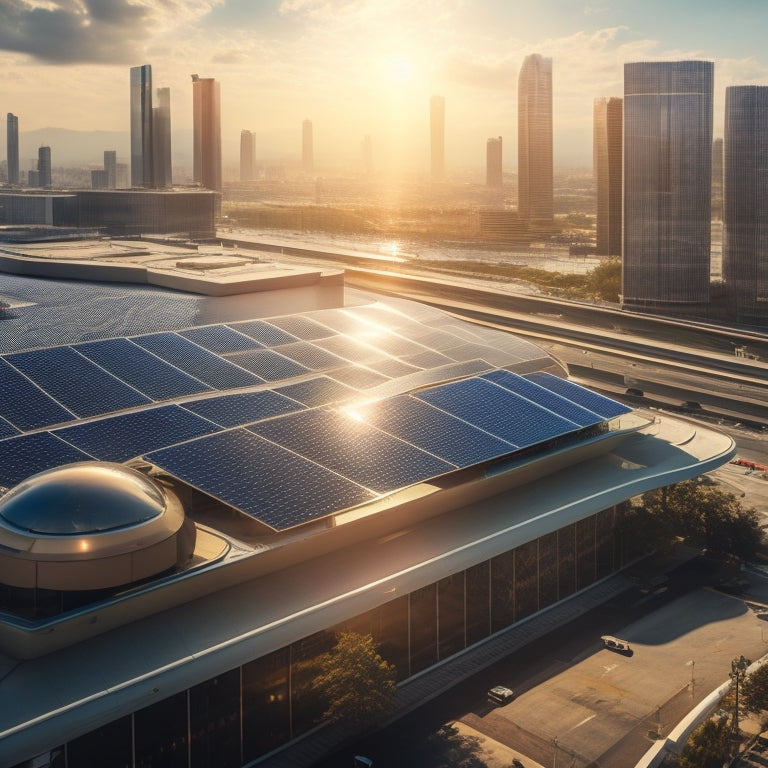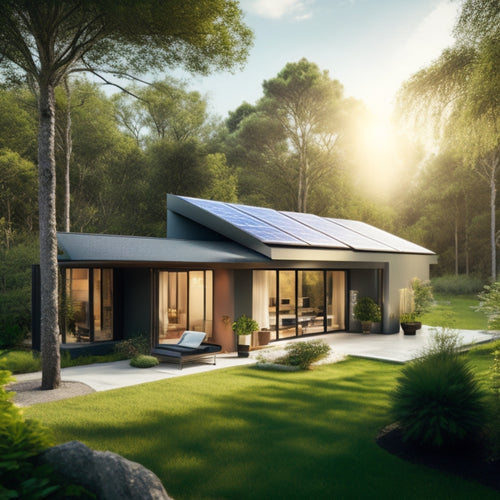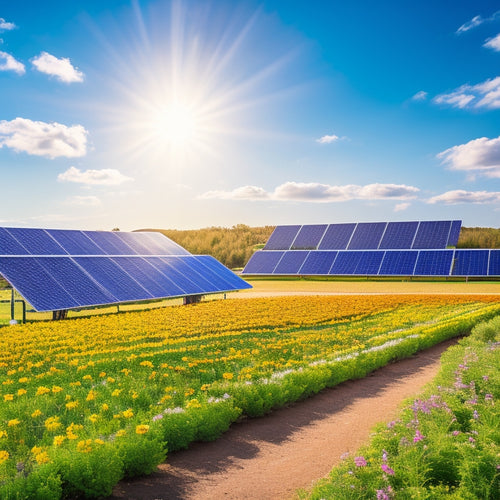
What Is the Cost of Solar Panels for Commercial Buildings
Share
When considering solar panels for your commercial building, you're likely looking at an initial investment of between $40,000 and over $1 million, depending on the system size and quality, with average costs ranging from $2.50 to $3.50 per watt. These costs can be offset by 30% to 50% savings on energy bills, making solar a viable option. Factors like system size, material quality, and installation complexity affect pricing, and financing options like PPAs, solar leases, and PACE financing can reduce upfront costs. As you weigh the costs and benefits, you'll want to examine the details that will ultimately drive your decision.
Key Takeaways
- The cost of commercial solar panels ranges from $40,000 to over $1 million, with average costs between $2.50 to $3.50 per watt.
- System size, material quality, and installation complexity are key factors influencing solar panel pricing for commercial buildings.
- The average cost breakdown for commercial solar panels is approximately 95% for hardware and installation, with panel quality variance affecting overall cost.
- Federal and state incentives, such as the Solar Investment Tax Credit, can reduce the upfront cost of commercial solar panels by up to 26%.
- Financing options like Power Purchase Agreements, solar leases, and PACE financing can reduce upfront costs and provide immediate energy savings for commercial buildings.
Understanding Commercial Solar Panel Costs
Understanding Commercial Solar Panel Costs
Typically, commercial solar panel systems range in size from 20 kilowatts to over 1 megawatt, with costs varying widely depending on several factors.
You'll find that the cost of a commercial solar panel system can range from $40,000 to over $1 million. However, the initial investment can be offset by significant energy savings over time. In fact, you can expect to save between 30% to 50% on your energy bills.
Financing options are available to help you get started, including power purchase agreements (PPAs) and solar leases. These options allow you to benefit from solar energy with little to no upfront costs.
With a PPA, you'll pay a fixed rate for the electricity generated by the solar panels, while a solar lease lets you rent the system for a fixed monthly payment.
Factors Affecting Solar Panel Pricing
When you're evaluating the cost of solar panels for your commercial building, you'll quickly realize that system size and material quality have a significant impact on pricing.
The larger the system, the more panels you'll need, which increases the overall cost.
Similarly, high-quality materials with higher efficiencies can also drive up costs, so it's crucial to take into account these factors in your calculations.
System Size Matters
About 95% of the cost of a commercial solar panel system comes from the hardware and installation. When you're evaluating solar panels for your commercial building, you'll want to reflect on system size. The larger the system, the more energy it can generate, but it also increases the upfront cost.
You'll need to balance your energy needs with your budget. A larger system doesn't always mean it's more efficient, though. System efficiency is a critical factor in determining how much energy your solar panels produce.
You'll want to assess the efficiency of each panel, as well as the overall system design, to guarantee you're getting the most bang for your buck. Achieving energy independence is a significant benefit of commercial solar panels.
By generating your own energy, you can reduce your reliance on the grid and lower your energy bills. As you evaluate system sizes, reflect on how much energy you need to generate to meet your business's requirements.
With the right system size and design, you can reveal the full potential of solar energy and start saving money.
Material Quality Varies
Your solar panel system's performance hinges on the quality of its materials, which greatly impact the overall cost. The type and quality of materials used can affect the system's efficiency ratings, material durability, and environmental impact.
When evaluating material quality, consider the following key factors:
-
Efficiency ratings: High-efficiency panels may be more expensive, but they can generate more power per unit area.
-
Warranty options: Look for manufacturers that offer extensive warranties with long-term coverage.
-
Brand reputation: Established brands with a proven track record of quality and reliability often come with a higher price tag.
While high-quality materials may come at a premium, they can also reduce lifecycle costs in the long run.
Additionally, technological advancements in installation techniques and manufacturing processes can also impact material quality and pricing. As you weigh your options, consider the trade-offs between upfront costs and long-term benefits.
Average Cost of Commercial Solar Systems
You're likely wondering what the average cost of a commercial solar system is, and the answer depends on several key factors.
System size matters, as larger systems typically cost less per watt than smaller ones.
You'll also need to take into account panel quality variance and installation complexity, which can greatly impact the overall cost of your commercial solar system.
System Size Matters
When sizing up a commercial solar panel system, the phrase "bigger is better" often rings true, but not always.
While a larger system can generate more electricity and increase energy savings, it's not always the most efficient or cost-effective option. You need to take into account your building's energy needs, available roof space, and local incentives to determine the ideal system size.
Here are three key factors to take into account when determining the best system size:
-
Energy usage: Assess your building's historical energy usage to determine how much electricity you need to generate to offset your energy costs.
-
Roof size and layout: Take into account the available roof space, obstructions, and orientation to determine the maximum system size that can be installed.
-
Local incentives: Research local government incentives, tax credits, and utility rebates that may influence the best system size and configuration.
Panel Quality Variance
The solar panel market offers a wide range of products, from budget-friendly options to high-efficiency premium panels, resulting in a significant panel quality variance that affects the average cost of commercial solar systems.
You'll find that high-efficiency panels come with a higher price tag, but they can also deliver higher panel performance, leading to more electricity generated per unit area. On the other hand, budget-friendly options may compromise on performance, but they're more affordable upfront.
When evaluating panel quality, you should also consider warranty options. Premium panels often come with longer warranties, typically 25 years or more, which can provide peace of mind and protect your investment.
In contrast, budget-friendly options may have shorter warranties, typically 10-15 years.
The panel quality variance directly impacts the average cost of commercial solar systems. While high-efficiency panels may cost more per unit, they can lead to lower costs per watt, making them a more cost-effective option in the long run.
You'll need to weigh the upfront costs against the potential long-term benefits to determine the best panel quality for your commercial solar system.
Installation Complexity Factor
As you weigh the benefits of high-efficiency panels against budget-friendly options, it's equally important to take into account the installation complexity factor that can greatly impact the average cost of commercial solar systems.
The installation complexity factor encompasses various aspects that can increase labor costs and project timelines. These include:
-
Design considerations: Customized system designs for complex roof structures or irregularly shaped buildings can drive up costs.
-
Permitting processes: Obtaining necessary permits and complying with local regulations can be time-consuming and costly.
-
Structural requirements: Additional structural support or modifications to the building may be necessary to accommodate the solar panel system, adding to the overall cost.
Site assessments, equipment compatibility, and installation challenges can also contribute to the complexity factor.
Incentives and Tax Credits Available
Beyond reducing your commercial building's carbon footprint, investing in solar panels can also considerably impact your bottom line, thanks to various incentives and tax credits available.
You can take advantage of federal incentives, such as the Solar Investment Tax Credit (ITC), which allows you to claim a tax credit of up to 26% of the total cost of your solar panel system. Additionally, many states offer their own credits, and local governments may provide rebates to encourage the adoption of renewable energy.
You can also investigate financing options, such as power purchase agreements (PPAs) or property-assessed clean energy (PACE) financing, to offset the upfront costs of solar panel installation.
By investing in solar, you'll not only reduce your energy bills but also benefit from tax deductions on the energy savings.
Moreover, going solar enhances your business advantages by demonstrating your commitment to sustainability, reducing your environmental impact, and contributing to a cleaner, healthier environment.
ROI and Payback Period Analysis
With your solar panel system up and running, you'll want to crunch the numbers to understand the return on investment (ROI) and payback period.
These metrics will help you determine the financial viability of your solar panel investment.
To calculate the ROI, you'll need to take into account the total upfront cost of the system, as well as any financing options you may have employed.
You'll also want to factor in the energy savings you'll realize over time, which can be substantial.
Here are three key factors to think about when evaluating the ROI and payback period of your commercial solar panel system:
-
Energy savings: The amount of money you'll save on your energy bills each year will have a direct impact on your ROI and payback period.
-
Financing options: The type of financing you choose can affect the upfront cost of the system, as well as the length of time it takes to recoup your investment.
-
System lifespan: The longer your solar panel system lasts, the more energy savings you'll realize, and the faster you'll see a return on your investment.
Commercial Solar Panel Installation Costs
Several factors contribute to the overall cost of commercial solar panel installation, and understanding these variables is essential for accurately budgeting for your project.
You'll need to evaluate the size of your system, the type and quality of equipment, and the complexity of the installation. The installation company's experience, labor costs, and permits also play a significant role.
On average, commercial solar panel installation costs range from $2.50 to $3.50 per watt, with most systems falling in the 50- to 500-kilowatt range. This translates to a total cost of $125,000 to $1.75 million for a typical commercial installation.
However, with solar panel financing options available, you can spread the cost over time and start enjoying energy savings from day one. In fact, many businesses see a significant reduction in their energy bills, often up to 50%, which can help offset the initial investment.
Maintenance and Operation Expenses
Your commercial solar panel system's performance and longevity rely heavily on regular maintenance and operation expenses. Neglecting these tasks can lead to reduced energy output, decreased solar panel longevity, and even system failure.
To avoid these issues, you should budget for routine maintenance, which includes:
-
Inspections: Regular visual inspections to identify potential issues, such as loose connections or damaged panels, and address them before they become major problems.
-
Cleaning: Cleaning the solar panels regularly to guarantee maximum energy output. Dirty panels can reduce energy production by up to 25%.
-
Inverter maintenance: Regular maintenance of the inverter, which converts DC power to AC power, to guarantee efficient energy conversion.
The maintenance frequency will depend on various factors, including the system's size, location, and environmental conditions.
On average, you can expect to spend around $1,500 to $3,000 per year on maintenance and operation expenses for a commercial solar panel system. This may seem like a significant cost, but it's a small price to pay for maximum system performance and extended solar panel longevity.
Frequently Asked Questions
Can I Install Solar Panels on a Leased Commercial Building?
You'll need to review your lease agreements to determine if installing solar panels is allowed, and if so, what installation considerations, like roof access and structural integrity, you'll need to address before moving forward with your project.
Do Solar Panels Affect the Roof's Warranty or Insurance?
You're maneuvering the solar panel installation process like a pro, but now you're wondering if they'll void your roof warranty or affect insurance implications. Rest assured, most manufacturers won't void your roof warranty, and insurance premiums might even decrease due to the added value.
Are Commercial Solar Panels Compatible With Existing Electrical Systems?
As you investigate solar energy, you'll find commercial panels seamlessly integrate with existing electrical systems, optimizing system integration and energy efficiency, ensuring a smooth shift to renewable power without compromising your building's energy infrastructure.
Can I Sell Excess Energy Generated Back to the Grid?
You're not just generating power, you're generating revenue. With net metering benefits, you can sell excess energy back to the grid through energy buyback programs, offsetting your utility bills and enhancing your bottom line.
Do Commercial Solar Panels Require Special Permits or Licenses?
You'll need to steer through the installation process, ensuring regulatory compliance, which involves obtaining necessary permits and licenses from local authorities, utility companies, and other stakeholders, to guarantee a smooth and legal commercial solar panel setup.
Conclusion
Now that you've crunched the numbers, it's clear that commercial solar panels can be a smart investment for your business. While upfront costs may seem steep, incentives and tax credits can greatly reduce the financial burden. With a typical ROI of 10-15% and a payback period of 5-7 years, solar panels can generate substantial savings over their 25-year lifespan. As you weigh the costs and benefits, remember that going solar is not only good for the planet, but also for your bottom line.
Related Posts
-

Top-Rated Solar Storage Solutions for Homeowners
When considering top-rated solar storage solutions, you're looking at systems that provide energy independence and si...
-

Integrating Smart Technology for Energy Savings
Integrating smart technology into your home is a transformative factor for energy savings. Smart thermostats give you...
-

High-Performance Solar Solutions for Sustainable Living
High-performance solar solutions are your gateway to sustainable living, maximizing energy efficiency while considera...


